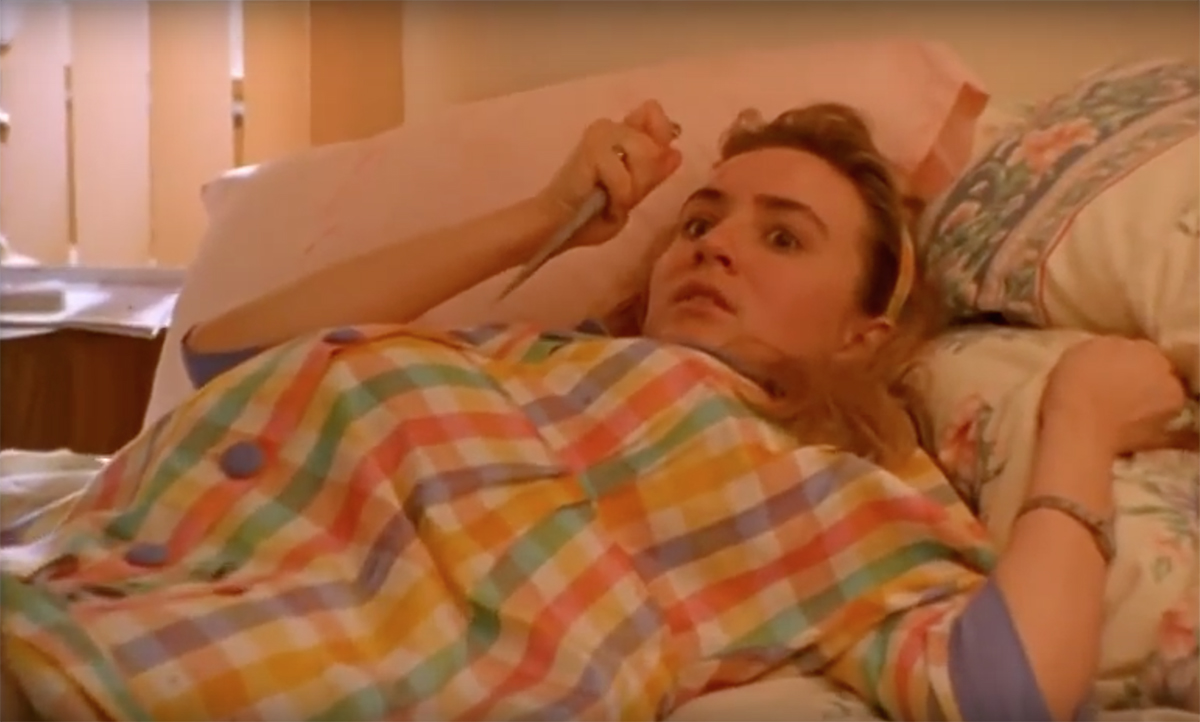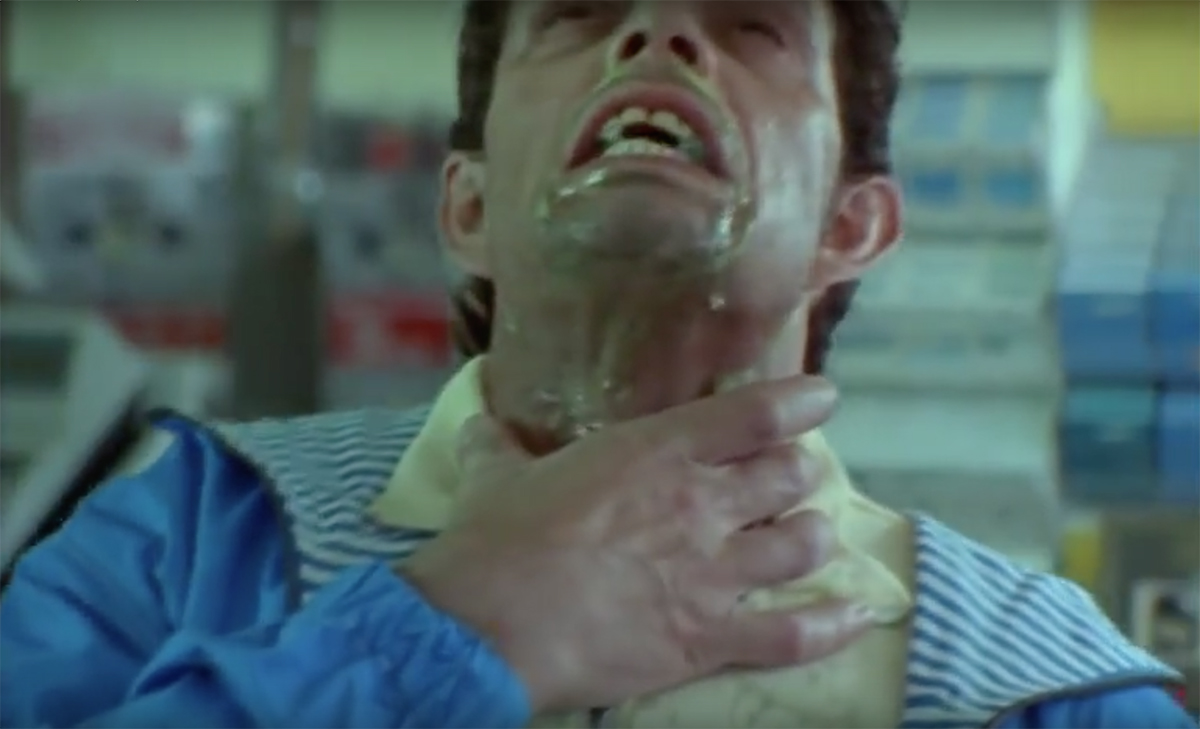
The Deep Archive: John O’Neill interviews Philip Brophy, 1994
Intestines explode, evil lurks in cul-de-sacs, a soapie star is devoured by her unborn child — this is the faux-nightmarish suburban world of, as David Stratton (a fan of Philip Brophy’s Salt, Saliva, Sperm and Sweat [47min, 1988]) puts it, “the yucky, schlocky, tongue-in-cheek horror film, Body Melt (1993).”
It’s a gloriously odd, low budget feature that diverges from the arc of Australian cinema in its refusal to embrace what is normally thought of as realism onscreen. The houses look like two-dimensional pop-ups, the acting, slime and gore are over-the-top and the people and the props look plastic. It’s all real in the mind of writer-director-artist Philip Brophy.
In the second ever edition of RealTime, John O’Neill spoke to Brophy about why he rejects naturalism as a mode of performance, why he prefers casting soapie actresses and extras from health insurance advertisements to ‘real’ actors and why he criticises what he sees to be the prevailing “ABC-drama aesthetic.”
Philip Brophy’s 1997- 2001 Cinesonics series about films and their soundtracks was commissioned by RealTime (not yet archived on our site but available on the writer’s website), as is the AudioVision series (2012-present).
Body Melt: Acting Degree Zero
RealTime #2, August 1994
Art-splatter auteur Philip Brophy tells John O’Neill why he casts his films in the ad breaks

Body Melt (1992)
Philip Brophy cast his first feature film, the schlock horror movie Body Melt, from television advertisements. “If I see most actors in an Australian movie I groan; I think ‘Oh, God’,” he says. “What I’m groaning at is what most people see as a sign of quality; some sort of ABC-drama aesthetic. I’d rather some Martians just came down and blew them all away.”
And, in a sense, that is what happens in Body Melt. Brophy’s film is centred on a cul-de-sac in an archetypal Australian suburb, Pebbles Court, where the residents have swallowed both the promotional hype and pills of a drug company that promises “cognition enhancement,” not at all unlike Prozac. The only problem is a willfully mis-held missing ingredient. As a result, the pills lead to horrific mutation and essentially turn people inside out. A jilted, similarly mutated genius who lives in the country town of “Nowhere” is ultimately revealed to be responsible.
The art of performance was, for Brophy, at its highest point in a scene where a young married couple, played by Brett Climo and Lisa McCune (a Coles New World girl from television advertisements and now a star in Blue Heelers), are confronted with the consequences of the drug. McCune’s character, eight months pregnant, discovers her unborn child is feeding off her. The genesis of the sequence was a television commercial for health insurance starring another, since successful theatre and film actor, Zoe Carides.
“She did this amazing ad that is just so disgusting,” says Brophy. “She’s down because she’s just had a baby in hospital. It’s all white. It’s just got this sterility to it. She’s handed her baby which she sees for the first time and then she’s unsure what to do. They’ve got this music with a woman who sounds like she’s orgasming while she sings piano breathlessly and there’s a tinkling piano. It’s a soft-rock ballad and then, suddenly, the baby smiles and Zoe breaks into tears and touches the little baby’s forehead with her forefinger. I thought: ‘Great, this is the person to drop her placenta.’”
Carides was unavailable but McCune (Cheryl in the film) was an equally “nice” stand-in whose performance enhanced the original. “Doctor,” she asks on the phone. “Is it possible to drop your placenta one month prior to birth?” Her unborn child then appears to rape her before the placenta suffocates her husband.
Brophy’s previous film was the 47-minute Salt, Saliva, Sperm and Sweat which is now available on video. Ironic and funny, it is driven by a synthesised musical soundtrack and Brophy’s actors, principally Jean Kitson and Phillip Dean, utter just 11 lines. They include: “Well, God, piss on me,” and “Knock your scrot on that dick-twister.”
“It’s virtually a form of puppetry,” says Brophy of film acting generally, and of Salt, Saliva… in particular. “It’s not that far from pornography: ‘Okay, pan back, right. Okay jerk off a bit to get an erection. You up yet? You up? Ok, quick, go in now. You scream. You scream. You scream.’ It’s not far removed from a dramatic situation where a director’s told the actor: ‘Ok, you come back to this mark. You stand there. You say that line, then turn. We’ll do the focus-pull on the lenses at that point, we’ll shift the reflector boards around and you move across there as the track comes back.’ Whether they’re saying: ‘I think we should get a divorce’ or having their head dunked into a bowl of shit (as occurs in Salt, Saliva…), the content of that action becomes slightly nullified or overridden by the mechanics of the whole situation.”
Salt, Saliva, Sperm and Sweat is a series of days in the life of “The Man” played by Phillip Dean. “Phillip always struck me as being like one of the Thunderbirds. I don’t like actors who are in my face, the whole Method approach. This emotional outpouring; this angst-ridden identification with the onscreen person etc,” Brophy says. As a result, Dean’s most contemplative and demanding performance moments occur while shitting — which Brophy acknowledges a great character actor like Robert de Niro could do well. But naturalism is a style to which Brophy doesn’t aspire.
“That’s only one option of how you can actually look at these strange, granular, floating, abstract, pseudo-photographic, ghostly images of people on a screen,” he says of realism. “In essence they are highly iconic and hieroglyphic anyway, just by their photographic status, despite their fleshy appearance.”
The consequence is that for Body Melt he has cast soap stars and other actors for their preconfigured iconography, and the icon that looms largest is Gerard Kennedy of Division Four and Homicide fame. “It goes back to this artificial logic of the whole film,” Brophy says. “Why have a cop in a film who is really only a plot device and try to pretend that somehow the person’s a character. Why not just go straight to an iconic instance of copness?”
Brophy also casts on the basis of voice. “The bulk of all changes in anyone’s expression doesn’t particularly come from their face,” he says. “I think the face is just a slight adjunct to the much greater range of tonal differences that happen in projection: shifts in pitch, paraphrasing, beats and what not. The projection, quality and delivery of the voice gives a much more precise impression of what the character is. The face doesn’t move around as much. This is marked when you’re watching something on a screen where the face just hovers there in a sense and is very often quite internalised in its projection.”
Body Melt was shown at the Melbourne Film Festival in June 1994 where, according to Brophy, it achieved the highest attendance of any film show. It has been sold to distributors in New York, England, Canada, Mexico, Turkey, Cyprus, Malaysia, the Phillipines and Thailand, and negotiations continue with Europe and Japan. In Australia, Brophy and producer Rod Bishop are organising theatrical release themselves.
–
John O’Neill was formerly Head of Events NSW and is now a Company Director for Komosion, Surfing NSW and Adopt Change.
Top image credit: Body Melt (1992)






